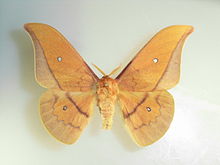
Silk is a natural protein fiber, some forms of which can be woven into textiles. The protein fiber of silk is composed mainly of fibroin and is produced by certain insect larvae to form cocoons. The best-known silk is obtained from the cocoons of the larvae of the mulberry silkworm Bombyx mori reared in captivity (sericulture). The shimmering appearance of silk is due to the triangular prism-like structure of the silk fibre, which allows silk cloth to refract incoming light at different angles, thus producing different colors.

Moths are a group of insects that includes all members of the order Lepidoptera that are not butterflies. They were previously classified as suborder Heterocera, but the group is paraphyletic with respect to butterflies and neither subordinate taxon is used in modern classifications. Moths make up the vast majority of the order. There are approximately 160,000 species of moth, many of which have yet to be described. Most species of moth are nocturnal, although there are also crepuscular and diurnal species.

Bombyx mori, commonly known as the domestic silk moth, is a moth species belonging to the family Bombycidae. It is the closest relative of Bombyx mandarina, the wild silk moth. Silkworm are the larvae of silk moths. The silkworm is of particular economic value, being a primary producer of silk. The silkworm's preferred food are the leaves of white mulberry, though they may eat other species of mulberry, and even leaves of other plants like the osage orange. Domestic silk moths are entirely dependent on humans for reproduction, as a result of millennia of selective breeding. Wild silk moths, which are other species of Bombyx, are not as commercially viable in the production of silk.

A pupa is the life stage of some insects undergoing transformation between immature and mature stages. Insects that go through a pupal stage are holometabolous: they go through four distinct stages in their life cycle, the stages thereof being egg, larva, pupa, and imago. The processes of entering and completing the pupal stage are controlled by the insect's hormones, especially juvenile hormone, prothoracicotropic hormone, and ecdysone. The act of becoming a pupa is called pupation, and the act of emerging from the pupal case is called eclosion or emergence.

The luna moth, also called the American moon moth, is a Nearctic moth in the family Saturniidae, subfamily Saturniinae, a group commonly named the giant silk moths.

Saturniidae, members of which are commonly named the saturniids, is a family of Lepidoptera with an estimated 2,300 described species. The family contains some of the largest species of moths in the world. Notable members include the emperor moths, royal moths, and giant silk moths.
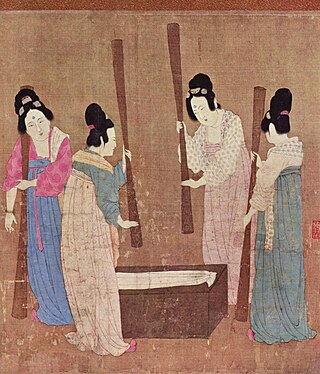
Sericulture, or silk farming, is the cultivation of silkworms to produce silk. Although there are several commercial species of silkworms, the caterpillar of the domestic silkmoth is the most widely used and intensively studied silkworm. This species of silkmoth is no longer found in the wild as they have been modified through selective breeding, rendering most flightless and without defense against predators. Silk is believed to have first been produced in China as early as the Neolithic period. Sericulture has become an important cottage industry in countries such as Brazil, China, France, India, Italy, Japan, Korea, and Russia. Today, China and India are the two main producers, with more than 60% of the world's annual production.

Samia cynthia, the ailanthus silkmoth, is a saturniid moth, used to produce silk fabric but not as domesticated as the silkworm, Bombyx mori. The moth has very large wings of 113–125 mm (4.4–4.9 in), with a quarter-moon shaped spot on both the upper and lower wings, whitish and yellow stripes and brown background. There are eyespots on the outer forewings. The species was first described by Dru Drury in 1773.
Assam silk denotes the three major types of indigenous wild silks produced in Assam—golden muga, white pat and warm eri silk. The Assam silk industry, now centered in Sualkuchi, is a labor-intensive industry.

The Saturniinae or saturniines are a subfamily of the family Saturniidae, also known as giant silkmoths. They are commonly known as emperor moths or wild silk moths. They are easily spotted by the eyespots on the upper surface of their wings. Some exhibit realistic eye-like markings, whilst others have adapted the eyespots to form crescent moon or angular shapes or have lost their wing scales to create transparent windows. They are medium to very large moths, with adult wingspans ranging from 7.5 to 15 cm, in some cases even more. They consist of some of the largest sized Lepidoptera, such as the luna moth, atlas moth, and many more. The Saturniinae is an important source of wild silk and human food in many different cultures.

Callosamia promethea, commonly known as the promethea silkmoth, is a member of the family Saturniidae, which contains approximately 1,300 species. It is also known as the spicebush silkmoth, which refers to is one of the promethea silkmoth's common host plants, spicebush. C. promethea is classified as a silk moth, which stems from its ability to produce silk, which it does in the formation of its cocoon. C. promethea lives in forests in the eastern U.S. and does not damage the trees on which it lives. The species was first described by Dru Drury in 1773.

Hyblaea puera, the teak defoliator, is a moth and cryptic species complex native to South Asia and South-east Asia. It was first described by Pieter Cramer in 1777. The species has also been recently reported to be present in Central America and Africa. The caterpillar feeds on teak and other trees. It is considered to be one of the major teak pests around the world.
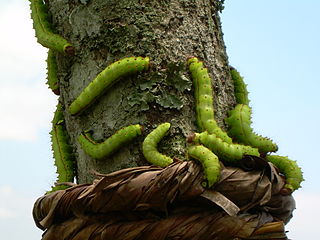
Wild silks have been known and used in many countries from early times, although the scale of production is far smaller than that from cultivated silkworms. Silk cocoons and nests often resemble paper or cloth, and their use has arisen independently in many societies.
Textile manufacturing is one of the oldest human activities. The oldest known textiles date back to about 5000 B.C. In order to make textiles, the first requirement is a source of fibre from which a yarn can be made, primarily by spinning. The yarn is processed by knitting or weaving to create cloth. The machine used for weaving is the loom. Cloth is finished by what are described as wet process to become fabric. The fabric may be dyed, printed or decorated by embroidering with coloured yarns.
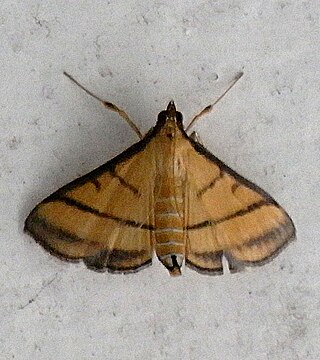
Cnaphalocrocis medinalis, the rice leafroller, is a species of moth of the family Crambidae. It is found in south-east Asia, including Hong Kong, Sri Lanka, Taiwan, Thailand and most of Australia.
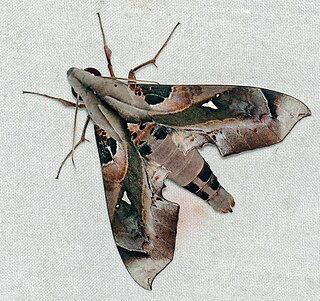
Madoryx plutonius is a moth of the family Sphingidae.

Antheraea paphia, known as the South India small tussore, the tasar silkworm and vanya silkworm is a species of moth of the family Saturniidae found in India and Sri Lanka. The bulk of the literature on this species uses a junior synonym, Antheraea mylitta, rather than the correct name, A. paphia. It is one of a number of tasar silkworms, species that produce Tussar silk, a kind of wild silk that is made from the products of saturniid silkworms instead of the domesticated silkworm.
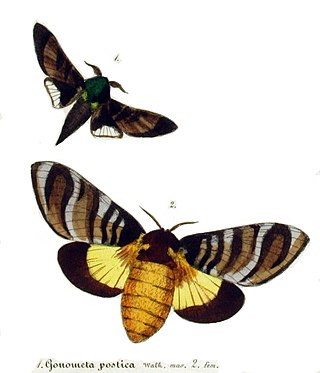
Gonometa postica, known commonly as the African wild silk moth, burn worm, and brandwurm, is a large species of African moth belonging to the family Lasiocampidae. The genus Gonometa boasts some very large moths and larvae; Gonometa sjostedti from Africa has a larva 16 centimeters long, for example. Most of the Lasiocampidae are highly sexually dimorphic. In G. postica the forewing of the male measures 21–25 mm and of the female 35–42 mm.
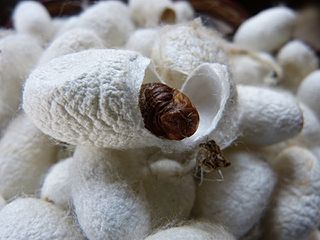
Ahimsa silk is a method of nonviolent silk breeding and harvesting. Wild silk moths are bred rather than the domestic variety. It allows the completion of the metamorphosis of the silkworm to its moth stage, whereas most silk harvesting requires the silkworms to be killed in their cocoon stage. No animals suffer or die for the silk to be produced, making it a favorable alternative to normal silk for those who object to harming animals.
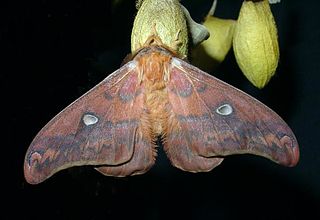
Rhodinia fugax, the squeaking silkmoth, is a moth in the family Saturniidae. It was described by Arthur Gardiner Butler in 1877. It is native to Korea, Japan, China, and the Russian Far East.
